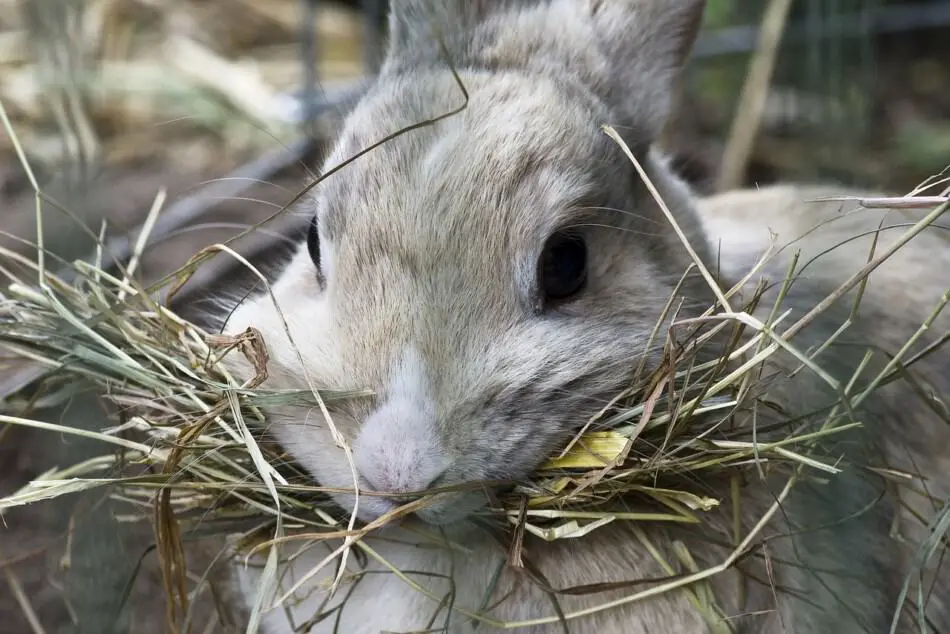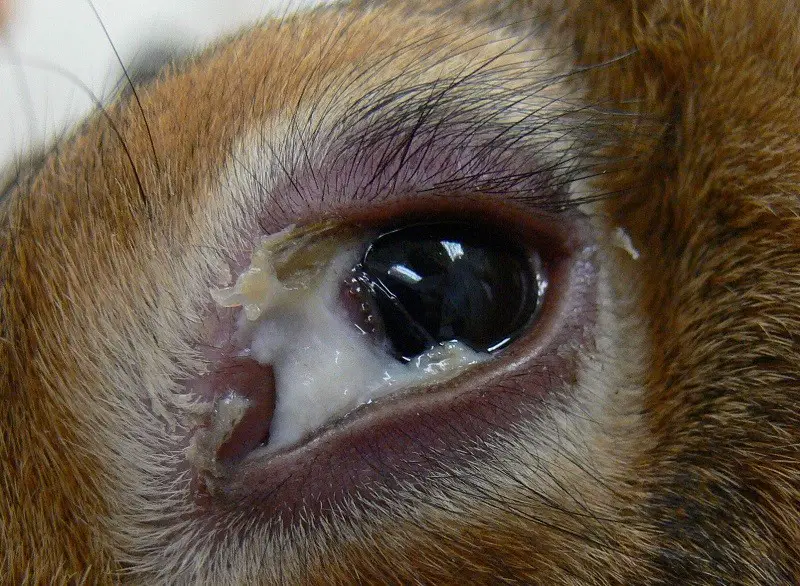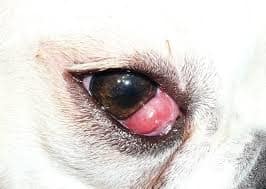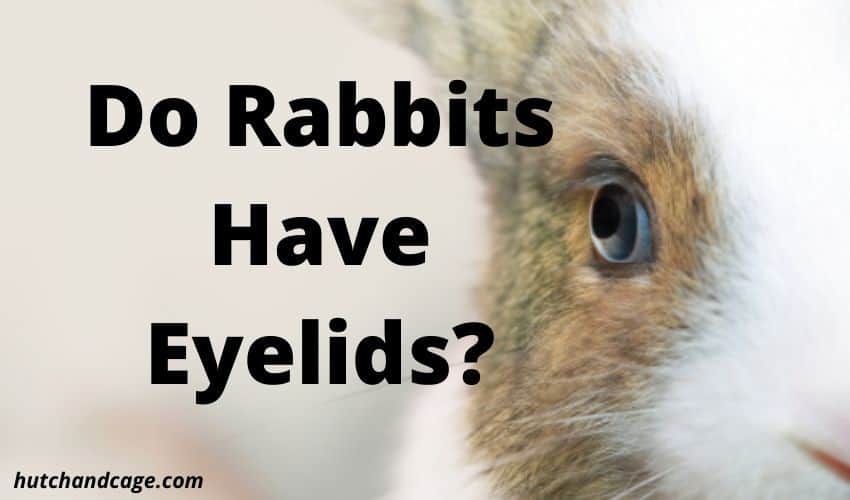I have been keeping rabbits and other small pets for many years now and I often get asked as the owner of this website some very strange questions.
But this one is not only strange but actually very interesting.
Not only do rabbits have eyelids,
This means they can sleep with their eyes open. More than anything, the nictating membrane is of great advantage to rabbits when it comes to surviving
Sometimes rabbits experience eye conditions that can hamper their health and wellbeing. These require special treatment, whether at the vet or at home.

Table of Contents
Why Do Rabbits Have Three Eyelids?
Rabbits blink their eyes only 10-12 times per hour. This is so that they can keep their eyes peeled for predators at all times.
After all, rabbits are the food source of choice for countless carnivorous animals, including wolves, foxes, hawks, and even humans. This means that they must be masters of escape if they are to survive.
The third eyelid that rabbits possess – the nictating membrane – exists for this purpose. To stay one step ahead of predators, rabbits must first be able to see them coming.
The nictating membrane allows rabbits to be able to see even when they are asleep. This is because it is transparent; when the nictating membrane is in place, rabbits are allowed to see limitedly and pick up on movement, etc.
At the same time, the nictating membrane releases fluid to keep rabbit eyes hydrated. This way, when they wake, their vision will not be slow from sleep.
They can quickly spot the danger and flee.
You can see why the health of the nictating membrane is of such importance.
They rely on it to sleep properly, and to protect themselves, night, day, dawn or dusk.
Can Rabbits See 360 Degrees?
Rabbit eyes are located laterally, which means on the sides of their heads. Due in large part to this, rabbits can indeed see in 360 degrees.
The exception is a small blind spot directly in front of them; if a predator has reached this point, the rabbit is unlikely to escape anyway.
While rabbits do possess 360 vision, their vision is not in fact incredible. Rabbits cannot see well at all during night or day, for example.
Additionally, while they do have a great visual range, they do not see in the best of detail. To gauge a threat, all a rabbit really needs to know is its size and proximity.
Their lateral eyes serve this purpose effectively.
Not only can rabbits see in 360, but their eyes corneas also take up a whole 30% of their eyes. A lot of physicality and energy are put toward the eyesight of a bunny.
This sense comes first, followed by hearing and smell closely.
Can Rabbits See In the Dark?
Actually, rabbits see the best during dawn and dusk. As a result, these are the times that they are the most active. Animals most active during dawn and dusk are known as crepuscular.
Rabbits sleep during the night, and during the day. They prefer to be out and about during times of dim lighting. Sometimes, when it is overcast, they are more active.

Do Pet Bunnies Have Good Eyesight?
The answer to this is both yes, and no. The eyesight of rabbits is truly excellent in terms of range. In terms of detail, though, it leaves something to be desired.
Their vision does what it is meant to do; alerts them to threats, with enough warning for them to get away.
The downfall of this far-ranging sight is that rabbits are more easily foiled up close. A stalking cat, for example, might be able to move closer without too much trouble.
In cases where the predator is already near, rabbits rely on their other senses heavily.
It may come as no surprise that rabbit hearing is rather extraordinary. They can pick up on rustles, the flap of wings from above, and even breaths.
Lesser-known is their powerful sense of smell. Because rabbits are grazers, by nature they eat frequently.
Their noses have adapted to be able to smell even through food. So, while they are tasting rich, green grass, they can still catch the separate odor of a predator nearby.
When it comes to eyesight range, bunnies blow many other animals away. When it comes to evading predators, this is a huge advantage.
How To Approach Your Bunny
Because rabbits are prey animals, it is important you keep this in mind when you approach them. Even a pet bunny can be spooked rather easily.
First and foremost, before you get close, make sure that your rabbit can see you clearly.
When interacting with a rabbit, move naturally (try not to move like a predator), and stay low to the ground otherwise.
The wisest method is to let the rabbit come to you, usually. Let them smell your hand and make the first move.
What Conditions Can Affect Your Pet Rabbit’s Eyes?
Rabbit eyes are so big and sensitive, it is no wonder that they are prone to some issues, whether condition or injury.
Luckily all of these are treatable. The following are the most common eye conditions in rabbits, as well as what you can do to help your little friend heal.
First and foremost, rabbits can get debris in their eyes. This can be anything from grass to dust, to dirt… any sort of matter can irritate their eyes.
A soft cloth dampened with water can serve to help you remove lesser debris. More serious blockages may require veterinary assistance.
Epiphora

Epiphora involves inadequate eye drainage, or excessive tearing, in rabbits. This is a sign that your rabbit is experiencing either debris, injury, or an eye condition.
Should your rabbit show signs of epiphora, find and treat the source right away.
Conjunctivitis AKA Pink Eye
A condition that rabbits can develop is conjunctivitis, more commonly known as pinkeye. As with humans, this involves the inflammation, discharge, and discomfort of the eye.
Pink-eye requires treatment with antibiotic eye drops, and often oral treatment as well. This will require a prescription from a vet, most likely.
Be sure to get your rabbit care for pinkeye quickly, as it tends to worsen otherwise.
Additionally, quarantine your bunny from other pets until it has made a recovery. Pink-eye is very contagious. Be sure to wash your hands after handling your sick bunny.
Duct Obstructions
Sometimes rabbits develop nasal infections as a result of eye duct obstructions. The eyes and nasal passages are linked closely.
The signs of nasal infection in rabbits are those of a classic cold; discharge, sneezing, and the like. This, too, requires treatment from a vet.
You can help your bun in the meantime using a rag to clean the outside of their nose. This may aid them in breathing more easily.
Eye Trauma and Cysts
Eye trauma and cysts are also a possibility. Avoid these by keeping your rabbit safe from pets and other potential danger sources.
Sometimes rabbits manage to scratch an eye anyway; in this case, the eye may heal on its own, or they may require veterinary assistance. Watch the situation closely.
Cherry Eye

Another unfortunate condition to which rabbits are prone is called cherry-eye. This is a prolapsed gland in the third eyelid.
The result is a swollen, reddish eye. While cherry-eye sometimes resolves itself, it is advised to seek veterinary help swiftly.
This is because your rabbit will be in some discomfort, and it is just as easy for the condition to become worse.
Do Rabbits See In Color?
Rabbits can see in color – their vision is just limited. They can differentiate between the colors green and blue.
This helps them pick out sky among the greenery, so they know to avoid hawks, eagles, and other threats from above.
Rabbits are protanopic, however. This means that they cannot see the color red. Once again, the color vision of rabbits is based on necessity.
The far-range vision and basic color-distinguishing ability serve to help them perceive threats effectively.
Conclusion: Do Rabbits Have Eyelids?
So, do rabbits have eyelids? They have three very effective ones. The third, unique eyelid, is known as the nictating membrane.
This not only serves as protection from debris but keeps rabbit eyes super-hydrated, so they are clear-eyed and ready to sense predators and flee.
This makes their third eyelid indispensable to their survival.
A rabbit with an eye injury is not likely to live long in the wild. Luckily, a pet rabbit has you to come to the rescue, so they can live a long and










